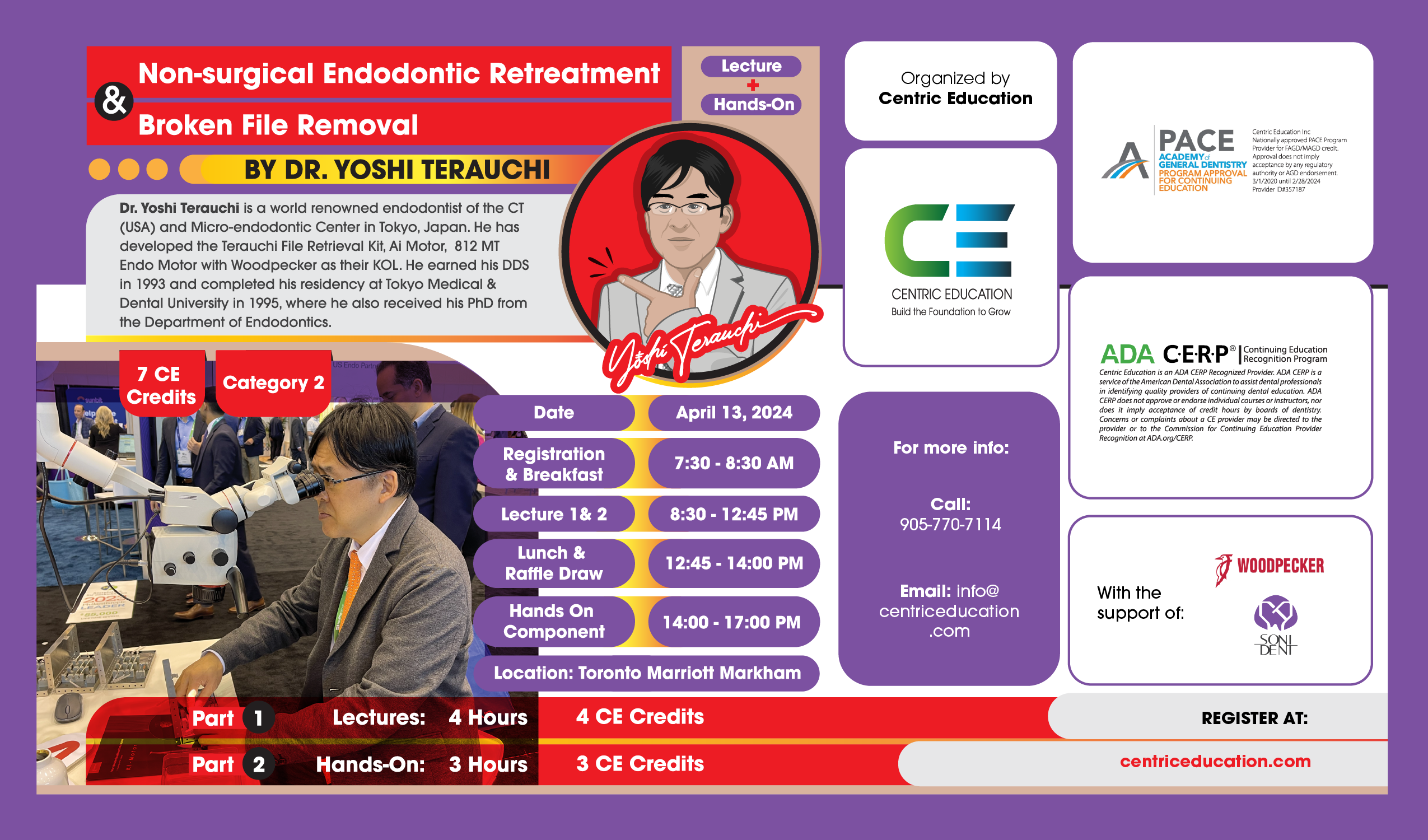
Non-Surgical Endodontic Retreatment & Broken File Removal By Dr.Terauchi
We're so excited to announce our new course "Non-Surgical Retreatment & Broken File Removal" lead by Dr.Yoshi Terauchi, world renowned Endodontist of the CT (USA) and Micro-Endodontic Center in Tokyo, Japan.
This class will be broken down into 3 parts, 1st lecture will be on Non-surgical retreatment, 2nd lecture will cover Minimally invasive and predictable broken file removal and lastly, there will be a hands on component that can be purchased separately.
Details:
Learning Objectives:
- Describe the accurate diagnosis and treatment plan for the standardized protocol for instrument retrieval.
- Perform a predictable and minimally invasive preparation for instrument retrieval.
- Perform the most predictable removal attempts of broken instruments.
Date: April 13, 2024 7:30am-5:00pm
7:30-8:30: Registration & Breakfast
8:30-12:45: Lecture 1 & 2
12:45-14:00: Lunch + Raffle Draw
14:00-17:00: Hands On Component. This includes a TFRK *Terauchi File Removal Kit valued at $1,163.00 , Shaped plastic blocks ,3D-printed teeth replicas with 3 mm broken files in visible places, EDTA , XP 3D shaper and #60/.02 HyFlex EDM (Optional)
Location: Toronto Marriott Markham (170 Enterprise Blvd, Markham, ON L6G 0E6)
Phone Number: (905) 770-7114
Email: info@centriceducation.com
Lecture 1 Abstract:
Non-surgical Endodontic Retreatment
Initial root canal therapy does not always result in healing for a multitude of reasons. Retreatment could also result in another failure unless the causes of the failure are identified. First, an accurate diagnosis is always the key to success especially in retreatment. Second, failure to adequately disinfect the root canal system may result in nonhealing if the causes of the failure are mainly odontogenic. Bacteria may persist following initial treatment due to the areas that were inaccessible to instrumentation and irrigation. Causes of treatment failure may include inaccurate diagnosis, lack of tooth isolation; inadequate cleaning, shaping, and irrigation, biofilm formation, and an incomplete obturation. In addition, iatrogenic accidents such as separated instruments, ledge formation, and perforation can also be serious problems leading to failure because of the inability to disinfect the canal system apical to those areas. In retreatment those mishaps that can adversely impact the treatment outcomes should be properly managed. Therefore, in the lecture, the ideal management of those nonhealing cases will be discussed and presented.
- Accurate diagnosis and treatment planning:
- How to differentiate odontogenic pain from non-odontogenic pain
- Diagnosis in retreatment
- Causes of non-healing cases:
- Where are the bacteria causing apical periodontitis?
- Where are the typical places for bacteria to form biofilms?
- Removal of gutta-percha root filling materials and biofilms:
- Why do the gutta-percha root fillings have to be removed in retreatment?
- What is the most efficient technique to remove root fillings?
- Management of ledged canals:
- How do you prevent ledge formation?
- What are the predictable and practical techniques to bypass ledges
- Predictable and minimally invasive instrument retrieval:
- Two key preparation techniques
- Two predictable removal techniques
- MTA obturation in retreatment (Perforation repair):
- Comparisons of clinical properties and root canal preparation between gutta-percha and MTA as a root filling material
- Predictable techniques for MTA obturation
Lecture 2 Abstract:
Minimally invasive and predictable broken file removal
The presence of the broken file in the canal hinders the cleaning and shaping of the root canal system, thereby resulting in compromising the treatment outcome. The success rates for removing fractured files widely range from 33% to 95% whereas instrument retrieval time using ultrasonic techniques also widely range from 3 minutes to over 60 minutes due to non-standardized techniques used for each case. The major disadvantage of the non-standardized protocol for instrument retrieval is unpredictable for each case and the excessive removal of sound dentin during the preparation, which may lead to iatrogenic accidents such as perforation and/or ledge formation. A recent study has shown that visible instrument retrieval is highly predictable if the standardized protocol is followed. In the workshop, the standardized protocol for instrument removal, which is both predictable and minimally invasive, will be taught and exercised using the new TFRK.
At the conclusion, participants should be able to:
- Describe the accurate diagnosis and treatment plan for the standardized protocol for instrument retrieval.
- Perform a predictable and minimally invasive preparation for instrument retrieval.
- Perform the most predictable removal attempts of broken instruments.
Organized by Centric Education
Sponsored by SoniDent & WoodPecker
(7 CE credits will be provided by Centric Education)
*Packages are priced before tax.
*By purchasing this item, you have agreed to the terms and conditions of the cancelation/refund policy linked above.
- Choosing a selection results in a full page refresh.
!
